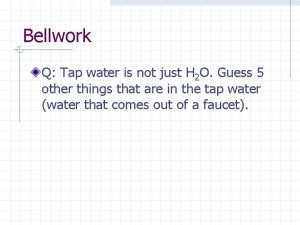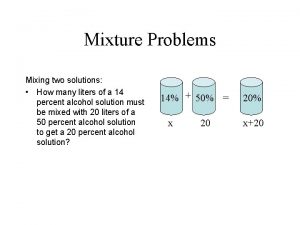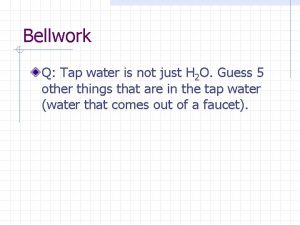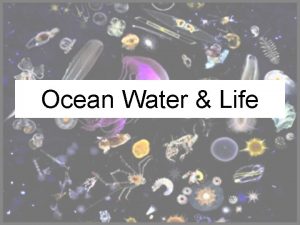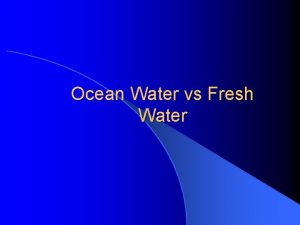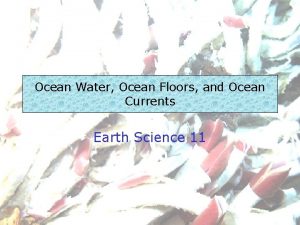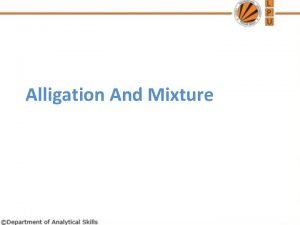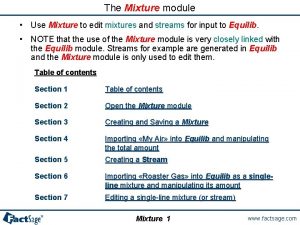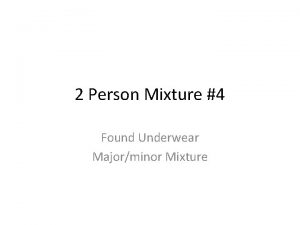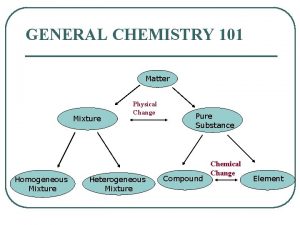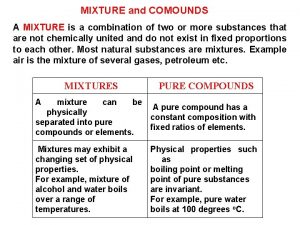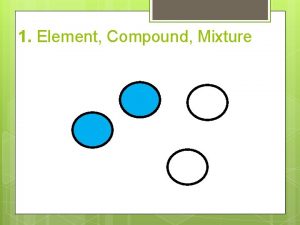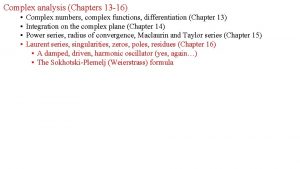OCEAN WATER Ocean water is a complex mixture




















- Slides: 20

OCEAN WATER

Ocean water is a complex mixture of plants, animals, dissolved solids and gases. Ocean water and water in general, have physical properties such as temperature, density, and salinity that help describe it. Scientists study these characteristics and the interactions among the oceans, the atmosphere, and the land.

Salinity Every year the Earth’s rivers carry about 2. 3 billion metric tons of dissolved solids into the oceans. The chemical weathering of rocks on continents is one source of elements found in seawater. Most of these dissolved solids are salts.

Gases also enter the water out of the atmosphere or by undersea volcanoes. The amount of dissolved materials has stayed balanced for millions of years because of the organisms that live off these materials.

About 4 billion years ago the Earth cooled enough for the moisture in the atmosphere to condense and torrential rains filled the ocean basins. Ocean water is 96. 5% pure water. The other 3. 5% are elements like chlorine, sodium, sulfur, calcium magnesium, and potassium. Other trace solids such as gold and zinc exist in small amounts.

The most abundant gases in the atmosphere are the most abundant gases dissolved in the ocean, Nitrogen, Oxygen and Carbon Dioxide which Carbon dioxide is most easily dissolved in water.

Temperature affects the amount of gas that dissolves in water. Gases dissolve better in cold water. Dissolved gases can also be released back into the atmosphere.

Dissolved solids make up about 3. 5% of the mass of ocean water. Sodium chloride, normal table salt Na. Cl makes up 78% of the oceans dissolved solids. The amount of dissolved solids present in ocean water is described by it’s salinity because most of the solids in ocean water are salts.

Both evaporation and freezing increase the salinity of ocean water. This is why tropical waters have a higher salinity than polar waters especially in summer.

There is also more salinity on the surface than at greater depths. Ocean water ranges anywhere from 38 or more parts per 1000 to 32 or less parts per 1000. The salinity stays constant because there is so much fresh water running into the oceans.

Ocean Temperatures Ocean water also absorbs solar energy depending on which latitude the water sits. Near the equator ocean temperatures are warmer than polar oceans because of the amount of direct sunlight received. The boundary between warm surface water and cold deep water is called a thermocline. As the depth of ocean water increases the temperature decreases.

The color of water is blue because that is the only color of light reflected by the water. The rest of the colors are absorbed.

Ocean Density is how heavy something is for its size. The density of sea water determines whether the water floats or sinks. Seawater is more dense than fresh water. Seawater density is influenced by two factors salinity and temperature. As ocean temperature decreases the density increases. The ocean is divided into 3 layers based on its density, a shallow surface mixed zone, a transition zone and a deep zone.

Life in the Oceans Living organisms in the ocean depend on two major factors: essential nutrients in the water and sunlight. Nearly all the life in the ocean is regulated by the life processes of plants. Animals an plants help maintain a balance of nutrients and gases that are required for them to live.

When surface water is blown by the wind, deep nutrientrich water moves up to take its place this is called upwelling. Plants grow only in the top 100 m of the ocean because the sun can only penetrate to about 200 m.

Marine organisms are classified according to where they live and how they move. Microscopic plants and animals called plankton serve as the base of food in the oceans. Plankton includes all organisms like algae, animals and bacteria that drift with the ocean currents. Zooplankton Phytoplankton

Larger animals called nekton are those that move independently of the currents usually by swimming.

Benthos refers to those animals that live on the ocean bottom.

The ocean is divided into life zones by three factors, the availability of sunlight, the distance from shore, and the water depth. The benthic environment is the bottom or ground zone. This zone is broken up into 5 zones based on the amount of light and organisms that live there. The pelagic zone is the open ocean and has a photic zone near the surface and an aphotic zone at about 200 meters down.

Some life lives at depth in the ocean and don’t need light to survive. They use the heat and chemicals that come out of hydrothermal vents. They are called chemosynthetic organisms.
 Is windex homogeneous or heterogeneous
Is windex homogeneous or heterogeneous Chapter 15 ocean water and ocean life answer key
Chapter 15 ocean water and ocean life answer key Water and water and water water
Water and water and water water Petroleum is a complex mixture of
Petroleum is a complex mixture of Pauline and bruno have a big argument
Pauline and bruno have a big argument Miliary tb
Miliary tb Simple compound complex sentences quiz
Simple compound complex sentences quiz The electra complex
The electra complex Freudian fixation
Freudian fixation Difference between oedipus complex and electra complex
Difference between oedipus complex and electra complex Convergent divergent transform
Convergent divergent transform Ocean ocean convergent boundary
Ocean ocean convergent boundary Convergent plate boundaries
Convergent plate boundaries Ocean ocean convergent boundary
Ocean ocean convergent boundary Convergent boundary
Convergent boundary Convergent oceanic oceanic plate boundary
Convergent oceanic oceanic plate boundary Blue og red ocean
Blue og red ocean Is tap water a heterogeneous mixture
Is tap water a heterogeneous mixture A 5 gallon radiator containing a mixture of water
A 5 gallon radiator containing a mixture of water Tap water pure substance or mixture
Tap water pure substance or mixture The periodic daily rise and fall of ocean water
The periodic daily rise and fall of ocean water

















